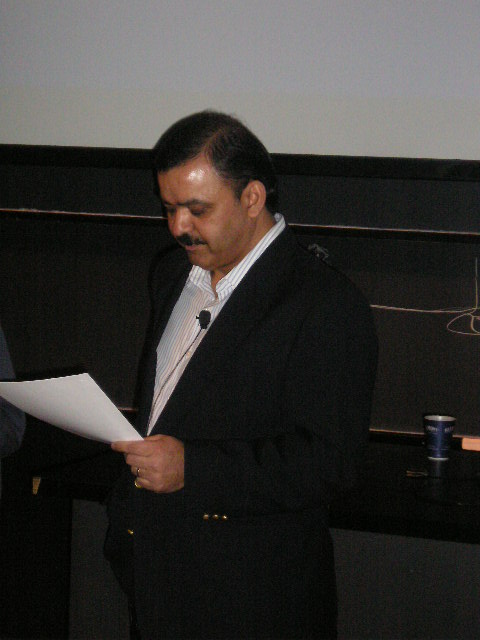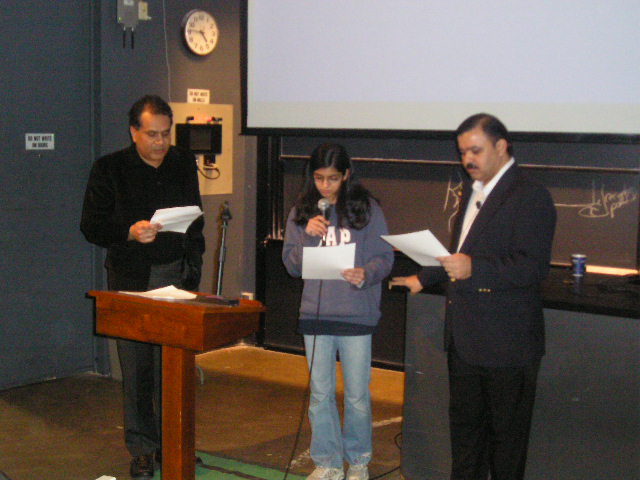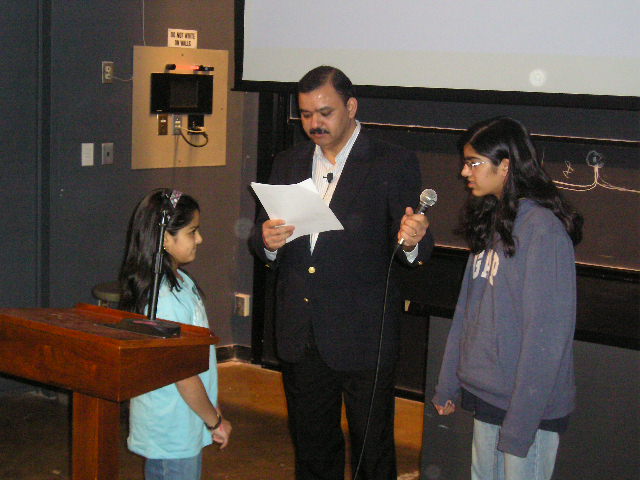Contribute
| Kashmiri Language And Literature |
02/20/2008
Lalit Koul, originally from Kashmir, India, presently living in Mansfield, Massachusetts, USA, recently delivered a presentation on Kashmiri Language and Literature, at Harvard University. The presentation was part of a series of presentations on Indian Languages and Literature, organized by Department of Sanskrit, Harvard University.
Lalit's presentation touched upon the origin, development and writing systems of Kashmiri Language. It also discussed the rich literature written in Kashmiri language and the challenges this language is facing in present times.
The presentation started with the introduction of Kashmiri as a northwestern Indo-Aryan language spoken primarily in the vale of Kashmir. The introduction also highlighted the scripts, varying from Sharada to Devanagari, that were used to write Kashmiri. It also touched upon how the language has survived largely as a result of it being "spoken" and how its survival is at stake given the large efflux of Kashmiri Pandits to various pockets of the world.
Lalit elucidated the two main contrasting theories as regards the origin of Koshur:
1. The Indo-Aryan (Dardic) Origin - Grierson's theory wherein he contends Kashmiri to be a special branch (Dardic) of Indo-Aryan languages and even equates Kashmiri with Pishachi. Grierson however ignores the predominance of Indo-Aryan vocabulary in Kashmiri that has its roots in Vedic language.
2. Vedic Origin. As per this theory, Kashmiri language originated from one of the dialects of which the classical Sanskrit was formed. Linguistically a large number of lexical and phonetic elements in Kashmiri can be directly traced to Vedic sources. Lalit highlighted the flaws in Grierson's theory and exemplified the order of words in imperative sentences resembling Hindi thereby further solidifying the link to the Sanskrit origin of Koshur.
After discussing the origin and its development, Lalit explained the scripts, Sharada and Devanagari, that were/are being used to write the literature in this language. The development path of both Sharada as well as Devanagari was presented in detail. The standardization process, technical development & adoption of and current state of Devanagari were explained thoroughly.
Next the presentation focused on the rich literature written in Kashmiri language. A chronology of the development of Kashmiri literature, beginning from 500 AD to present times, was also presented. Scholars like Damodara, Abhinavagupta, Kalhana and Biehana were recognized for their contributions. Emphasis was laid on Lalleshwari "Lal Ded" for her "Vaakhs", Shah Nuruddin also reverred as "Nund Ryosh or Nund Rishi" for his "Sruks", Zain-ul-Abidin also known as "Budshah" for his role in development of art and culture in Kashmir and his encouragement to poets and writers of all languages. Islamic Rule and its adverse influence on the indigenous languages like Sanskrit and Kashmiri was highlighted. Literature, mainly in the form of poems of yearning, written by Habba Khatoon and Arni Maal was given due recognition. Other prominent writers like Kh awajah Habibullah Naushari, Sahib Kaul, Rupa-Bhavani, Prakasa-rama were introduced. The influence of poets like Mahmud Gami, Parmanand, Lakshman Ju, Krishna Razdan and Abdul Wahab Pare during the period of 1800-1900 was discussed. The literature section of the presentation ended with the focus on Post-1900 era and the scholars like Pirzada Ghulam Ahmed "Mahjoor", Abdul Ahad Azad, Pt. Zinda Kaul, Nandalal Kaul, Dina Nath Nadim, Rahman Rahi, Sarvanand Kaul "Premi", Moti Lal Saqi, Dr. Shashi Shekhar Toshkani, Bansi Lal Wali "Nirdosh" and M.K. Raina et al. Their respective scholarly works were introduced.
Kashmiri authors like Zinda Kaul "Masterji", Pushkar Bhan, Moti Lal Saqi, Moti Lal Kemmu, Dina Nath Nadim, Pran Kishore and Hari Krishen Kaul, who have been awarded Sahitya Akademi Award for literature, were identified for their rich literary work.
After the discussion on Kashmiri literature, few literary works were recited. Lalit recited few popular Lal Vaakhs and Dina Nath Nadim's poems. The audience were also enthralled with the Koshur songs like “Rind Posh Maal Gindnay Drayi Lo Loâ€, “Rosh Valla Myaniya Dil Baro†and “Walo Mashouk Myaneâ€. The audience was stunned with the beauty of the valley they saw in these musical video clips.
The final highlight of the presentation was the live conversation of daily routine talk within a typical Kashmiri family. Lalit’s two young daughters Rashmi and Megha participated in this part of the presentation and conversed in typical Kashmir to present a flavor of vocal Kashmiri to the audience. Randhir Bhan of Norwood, Massachusetts also participated as a conversationalist during the presentation.
The audience comprised of few local Kashmiri Pandits, Non-Kashmiri-Speaking Indians and few Americans who are studying Indian languages like Sanskrit.
You may also access this article through our web-site http://www.lokvani.com/


